We all love holly for the holidays, and so do birds. We value native hollies for decorations and for landscaping, while birds appreciate their berries, abundant during the lean times of winter. The American holly, (Ilex opaca), is the only native holly with evergreen spiny leaves and red berries – the classic characteristics of holly.
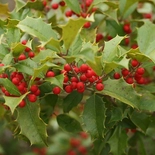
American Holly(Ilex opaca)
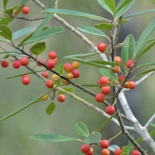
Dahoon(Ilex cassine)
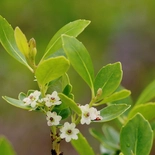
Inkberry(Ilex glabra)
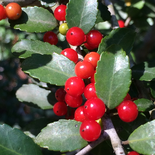
Yaupon(Ilex vomitoria)
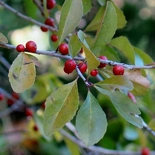
Possumhaw(Ilex decidua)
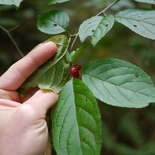
Mountain Holly(Ilex montana)
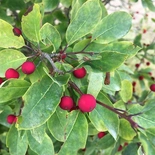
Catberry(Ilex mucronata)
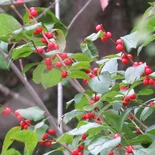
Common Winterberry(Ilex verticillata)
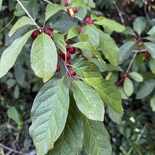
Sarvis Holly(Ilex amelanchier)
But there are a number of other native hollies, all found in the eastern half of North America, which are equally handsome and fruitful. The evergreen species, in addition to the American holly, include dahoon, (I. cassine), inkberry (I. glabra), and yaupon (I. vomitoria). The deciduous species include, possum-haw (I. decidua), big-leaf holly (I. montana), mountain holly (I. mucronatus, formerly Nemopanthus m.), winterberry (I. verticillata), and the rare sarvis holly (I. amelanchier). There are several other native Ilex species, but they are not as well known, and are infrequently used in landscaping.
Value for Birds
Holly berries, although poisonous to humans, are nutritious fruits for birds. The berries are particularly valuable because they persist through December and into winter, even into spring in some holly species. The birds, for unknown reasons, seem to prefer them later in the season.
Twenty-nine species of birds are known to eat holly berries, including eastern phoebes, the American crows, gray catbirds, brown thrashers, American robins, eastern bluebirds, cedar waxwings, white-eyed vireos, and northern cardinals, as well as many thrushes, woodpeckers, and other songbirds. In addition, wood ducks, wild turkeys, ruffed grouse, northern bobwhites, and ring-necked pheasants feed on the fruit.
Hollies also provide nesting and cover for birds. Known nesters include the northern mockingbird, American robin, veery, cedar waxwing and red-winged blackbird. The evergreen hollies are particularly valuable for winter cover.
Other Wildlife Values
Hollies are insect-pollinated and, although the honey-fragrant flowers are usually inconspicuous, horticulturist William Cullina writes that every bee and hoverfly in the neighborhood will visit hollies when in bloom. The flowers also attract butterflies and moths. The American holly and winterberry are host plants for Henry’s elfin butterfly. Yaupon hosts the elf butterfly. Mountain holly is a host plant for the Columbia silkmoth (very similar to the better-known cecropia moth).
Mammals which use holly berries as a food source include deer, bear, opossums, rabbits, raccoons, mice, and squirrels.
Landscape Notes
Hollies have long been popular in landscaping. The evergreen species have been used primarily for their foliage. Most deciduous species have abundant, long-lasting berries, which are especially showy after leaf fall – perfect for fall and winter gardens.
The various species have different native ranges in the Eastern U.S. and Canada, so you’re likely to find one native to your particular area. The big leaf holly is native to the Appalachians. Inkberry and American holly grow along the most of the Atlantic coast, and the latter is also found native inland to Texas and Florida. Winterberry ranges from southern Canada, south to Minnesota, Missouri, and Florida. Mountain holly is native from southern Canada, west to Minnesota, and south to the mountains, from West Virginia to North Carolina. All the others mentioned above are native to the southeastern coastal plain.
All our native hollies are shrubs to small trees, and prefer moist acidic soils. They fruit best in sunny locations, but can tolerate light shade. Most have red berries, but inkberry, as its names suggests, has black berries.
Hollies are dioecious, requiring both male and female plants for fruiting. The male plants, lacking the showy fruits, are generally relegated to a back corner of the garden, but Cullina suggests that it is best to have them within 50 feet of the female for good fruit set. Also, at least three or four plants should be planted to insure both sexes for fruiting. However, male and female cultivars are available – use one male for every five female plants.
Cultivars are often superior in fruit set and vigor, and for this reason, could be better for wildlife. Thus, holly cultivars may be an exception to the rule of avoiding cultivars in favor of genetic diversity. However, Douglas Tallamy, author of Bringing Nature Home, warns that some cultivars of winterberry may produce berries too large for some birds to eat, so it would be best to check this out before purchasing a cultivar. Berries which are 3/5-of-an-inch in diameter are best for most birds.
Winterberry is the hardiest and most showy of our native hollies. It is also the one I know best, having seen spectacular specimens of the shrub, when leafless and laden with beautiful red berries, in the snow. Much to my regret, my soil is too droughty for winterberry, which is most at home in bogs and wetlands. To research this article, I revisited Beulah Bog, one of the southernmost bogs in Wisconsin, wearing knee-high boots over a boardwalk mostly underwater, where the only wild winterberry near my home grows happily.
Nonetheless, some experts say that winterberry can tolerate moderately well-drained soils, as long as they are not too dry. Like other hollies, winterberry prefers acidic soils, but can tolerate alkaline soils to pH 8.0 These features, plus its gorgeous berries, which brighten the holidays and persist into late February, make it one of the most widely used and popular hollies.

